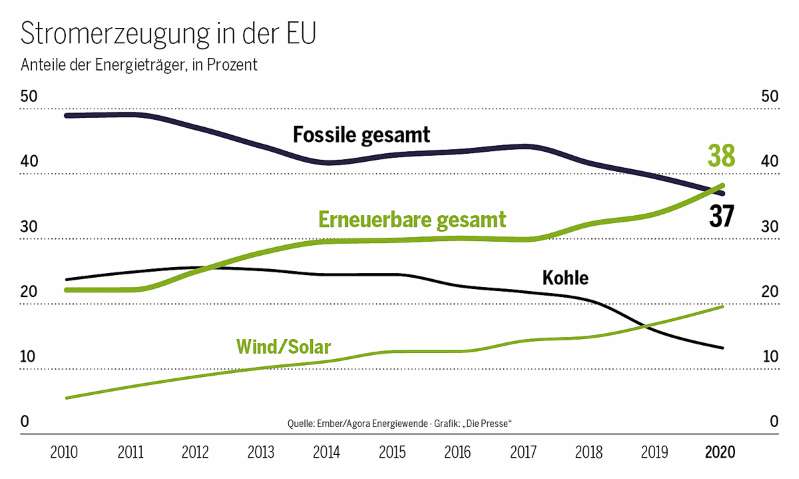
2020 will go down in history as the greenest electricity year ever. For the first time, electricity generated from renewable sources exceeded that from fossil fuels. In the previous year, renewables had a share of 38 percent in the European electricity mix, fossil fuels only made up 37 percent. This is shown by an analysis by the British think tank Ember and the German think tank Agora Energiewende.
The changing of the guard was driven primarily by the rapid growth in wind and solar generation. This has almost doubled since 2015 and in 2020 accounted for a fifth of the European electricity mix.
Denmark is the undisputed leader. While wind and solar power accounted for around 20 percent ten years ago in the Nordic country, an unprecedented expansion campaign led the Danes to wind and solar power at 61 percent. Ireland (35 percent), Germany (33 percent) and Spain (29 percent) follow far behind.
Austria has some catching up to do
In a European comparison, Austria is in the lower third. Only twelve percent of the electricity comes from wind or solar energy. In 2010 it was only three percent, so a lot has happened since then. And in the coming years, the proportion of sun and wind is set to increase again significantly with record subsidies. And one thing has to be given to Austria anyway: Due to the high proportion of hydropower (around 60 percent), when it comes to renewables, it is in the absolute top field in Europe.
| The rapid growth of wind and solar energy has forced coal to decline. |
| Dave Jones, Ember electricity analyst and study author |
|---|
Not least because the coal plant in Mellach in Styria was the last domestic coal-fired power plant to shut down last year. With this, Austria confirms the European trend – more and more countries are withdrawing from coal-fired power generation. Across Europe, the share of coal has halved since 2015. In 2020 alone, this fell by a fifth. Coal-fired power plants thus only supplied 13 percent of Europe's electricity. “The rapid growth of renewables has forced coal to decline,” said Dave Jones, Ember's lead electricity analyst and lead author of the report.
By contrast, generation from natural gas only fell by four percent in 2020. The background to this uneven development is the significantly higher price for emissions certificates. As a result, comparatively climate-friendly gas-fired power plants often produced the cheapest electricity among fossil-fuel power plants. In Germany, Poland and the Czech Republic they even undercut lignite-based power generation for a few months for the first time.
“Green Deal” will reinforce the trend
European electricity demand fell by four percent in 2020 and hit a low in April during the first wave of Covid-19. The partial closure of the industry was primarily responsible for this. A further decline in fossil fuels was slowed down by the increase in electricity demand later in the year. The study also found that Europe's electricity was 29 percent less CO2 intensive in 2020 than in 2015.
According to the authors of the study, the green changing of the guard in power generation is an “important milestone” in European energy development. The authors are sure that the “Green Deal” of the EU Commission will give the triumphant advance of renewables a further boost.

